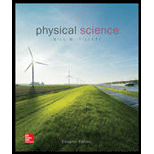
Concept explainers
What is the most abundant compound near or on the surface of Earth?
a. O2
b. H2O
c. CO2
d. N2
The most abundant compound near or on the surface of earth from the given options:
a.
b.
c.
d.
Answer to Problem 1AC
Solution:
Option (b) is correct.
Explanation of Solution
Introduction: The earth is covered by about 70 percent water only. Water is the highest abundant compound compared to the other compounds such as minerals. And on an average about 98 percent of water exists in the state of liquid.
Explanation:
Reason for the correct option:
The space-based satellite picture of the earth gives an evidence that most parts of earth are being covered by water. Water covers 70 percent of earth’s surface, which is 6 or 7 times more than any other abundant material present on earth.
Hence, option (b) is correct.
Reasons for the incorrect options:
Option (a) is incorrect because water is the most abundant compound present on the earth’s surface.
Option (c) is incorrect because water is the most abundant compound present on the earth’s surface.
Option (d) is incorrect because water is the most abundant compound present on earth’s surface.
Hence options (a), (c) and (d) are incorrect.
Conclusion:
The most abundant compound near or on the surface of earth is
Want to see more full solutions like this?
Chapter 24 Solutions
Physical Science
Additional Science Textbook Solutions
Applied Physics (11th Edition)
Fundamentals Of Physics - Volume 1 Only
Physics for Scientists and Engineers, Technology Update (No access codes included)
College Physics: A Strategic Approach (3rd Edition)
Introduction to Electrodynamics
Life in the Universe (4th Edition)
- One gallon of paint (volume = 3.79 103 m3) covers an area of 25.0 m2. What is the thickness of the fresh paint on the wall?arrow_forwardHow does sedimentary rock from the ocean floor sometimes end up in highland and mountainous regions on the Earth? (22.5) (a) Sedimentary rock is commonly made inside volcanoes. (b) Wind and water carry the sediment to the mountaintops. (c) It is believed that asteroid impacts probably caused the sedimentary rock to move great distances. (d) The sedimentary rock was uplifted by powerful forces to form mountain chains.arrow_forwardDescribe each of the following and state whether it is a fast or a slow type of mass wasting: (a) rockslide, (b) creep, and (c) slump.arrow_forward
- What kind of deformation does a cube of Jell-O exhibit when it jiggles?arrow_forward2. How many U.S. gallons are there in a cubic mile? The total proven oil reserves of the U.S. areroughly 30 ×10^9 bbl. How many cubic miles is this?arrow_forward8. A 7.3-magnitude earthquake hit eastern Japan late Wednesday night,killing at least four people and injuring over 100 others, and cutting power to millions of homes. a) Determine the amount of energy released by the earthquake in ergs? b) How much energy was released in Joules?arrow_forward
 An Introduction to Physical SciencePhysicsISBN:9781305079137Author:James Shipman, Jerry D. Wilson, Charles A. Higgins, Omar TorresPublisher:Cengage Learning
An Introduction to Physical SciencePhysicsISBN:9781305079137Author:James Shipman, Jerry D. Wilson, Charles A. Higgins, Omar TorresPublisher:Cengage Learning College PhysicsPhysicsISBN:9781305952300Author:Raymond A. Serway, Chris VuillePublisher:Cengage Learning
College PhysicsPhysicsISBN:9781305952300Author:Raymond A. Serway, Chris VuillePublisher:Cengage Learning Principles of Physics: A Calculus-Based TextPhysicsISBN:9781133104261Author:Raymond A. Serway, John W. JewettPublisher:Cengage Learning
Principles of Physics: A Calculus-Based TextPhysicsISBN:9781133104261Author:Raymond A. Serway, John W. JewettPublisher:Cengage Learning Physics for Scientists and Engineers with Modern ...PhysicsISBN:9781337553292Author:Raymond A. Serway, John W. JewettPublisher:Cengage Learning
Physics for Scientists and Engineers with Modern ...PhysicsISBN:9781337553292Author:Raymond A. Serway, John W. JewettPublisher:Cengage Learning Physics for Scientists and EngineersPhysicsISBN:9781337553278Author:Raymond A. Serway, John W. JewettPublisher:Cengage Learning
Physics for Scientists and EngineersPhysicsISBN:9781337553278Author:Raymond A. Serway, John W. JewettPublisher:Cengage Learning Horizons: Exploring the Universe (MindTap Course ...PhysicsISBN:9781305960961Author:Michael A. Seeds, Dana BackmanPublisher:Cengage Learning
Horizons: Exploring the Universe (MindTap Course ...PhysicsISBN:9781305960961Author:Michael A. Seeds, Dana BackmanPublisher:Cengage Learning





